What to do if the cherry is wormy
Cherry is a very tasty berry. It is not cheap on the market, so many people grow the crop on their plots. But cherries are capricious; insect pests love them. The most common problem gardeners have is worms in cherries. What kind of insects are these and what to do if the cherry is wormy, we will tell you in this article.
Why are cherries wormy?
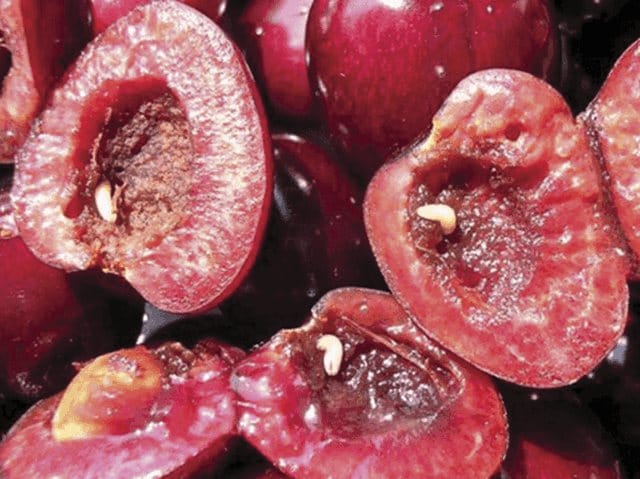
Insect pests are a scourge for gardeners. When white worms appear in a cherry tree, this almost always indicates that the tree is infected with a cherry fly.
This is an extremely dangerous pest. It can quickly destroy the entire harvest of cherries. The insect has a well-developed sense of smell, and a fly can fly to the smell of fruits from a great distance. If there are plants in neighboring areas that are affected by this pest, then there is a high probability that you will also have a fly. This is why worms appear in cherries.
Life cycle of cherry fly
It is not always possible to notice the appearance of a cherry fly in time. If black spots appear on the fruits and this is left unattended, the harvest may be lost. The black dots are puncture sites for egg laying.
Berries affected by the fly change their appearance, become dull, and soften. After some time, the black dots turn into depressions, and many berries begin to rot.
In one calendar year, a generation of flies goes through a full life cycle. Under unfavorable weather conditions, insects burrow into the ground and enter diapause. In this state, the cherry fly remains viable for 2-3 years.
With the onset of spring, the insect begins to reproduce. Cherry and cherry trees are the most favorable environment for them.
If you know all the stages of the insect's life cycle, the fight against it will be much more effective.

Flight and mating stage
In the spring, when the earth warms up to +10...+12°C, adults - adult cherry flies - begin to emerge from the pupae. This period occurs in the second half of May, when acacia begins to bloom.
Before laying eggs, females begin to eat off the acid of leaves, secretions of aphids or the juice of unripe fruits. An adult fly reaches a length of 3-6 mm. After about 2 weeks, the insects mate. Females lay eggs in sunny weather at an air temperature of at least +18°C. The insect pierces the skin of the fruit and lays eggs.
The pest years last through June and parts of July. During this time, the fly manages to destroy green fruits and ripe cherries.
Female cherry flies die after laying eggs.
Reference. An important food source for the cherry fly is the cherry aphid. If you regularly get rid of aphids, the fly will migrate to other places in search of food.
Larval stage
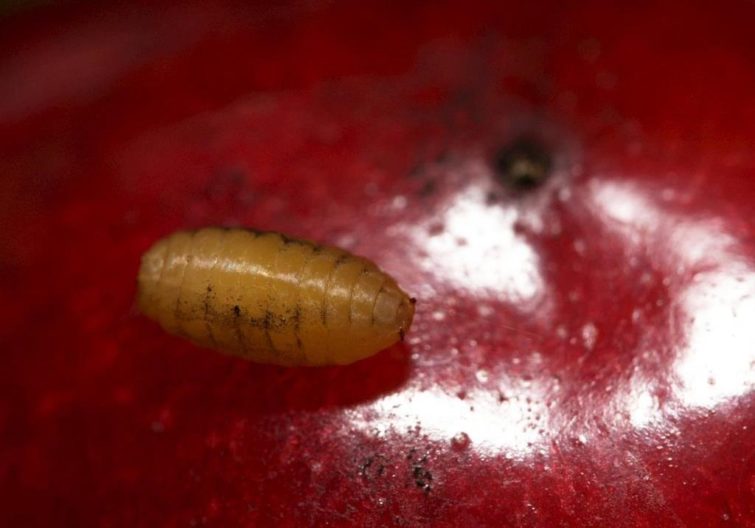
The larvae hatch approximately 2 weeks after the eggs are laid. Despite the fact that the body of the larva at the initial stage is only 0.5 mm, this does not prevent it from eating the pulp of the fruit in order to get to the seed.
The insect lives in the larval stage for about 20 days and reaches a maximum length of 7 mm.
The grown larva leaves the fruit and pupates.
Pupa stage
The cherry fly pupa needs a low temperature to develop - no higher than +7°C.For two or three winters, the pupae develop in diapause in the ground, and only in the spring, when the soil temperature rises to +5...+10°C, do adult individuals emerge from them.
Reference. Cherry fly pupae are usually found around the perimeter of the crown of a cherry tree.
Damage caused by a fly
Cherry fly lays eggs in berries. If the fruit is green, it rarely ripens, and if it is ripe, it begins to rot. Even if you notice 2-3 wormy berries, it is better to take protective measures against insects, otherwise you risk losing the entire harvest.
The warmer the climate, the more often the fly appears in cherry and cherry orchards. Every year the pest increases its population size. If you do not fight the insect at the very beginning of its appearance, it will be very difficult to get rid of this scourge.
Fighting cherry fly on cherries
If there are worms in cherries, how to get rid of them is a very common question for gardeners who grow this berry. There are chemical and folk methods of control. Each of them has its own rules and deadlines.
The cherry fly is a very malicious and tenacious pest.. If the fight against it with drugs is carried out incorrectly, there will most likely not be an effective result.
So how to deal with worms in cherries? It is best to purchase special insecticides and use them to get rid of the pest.
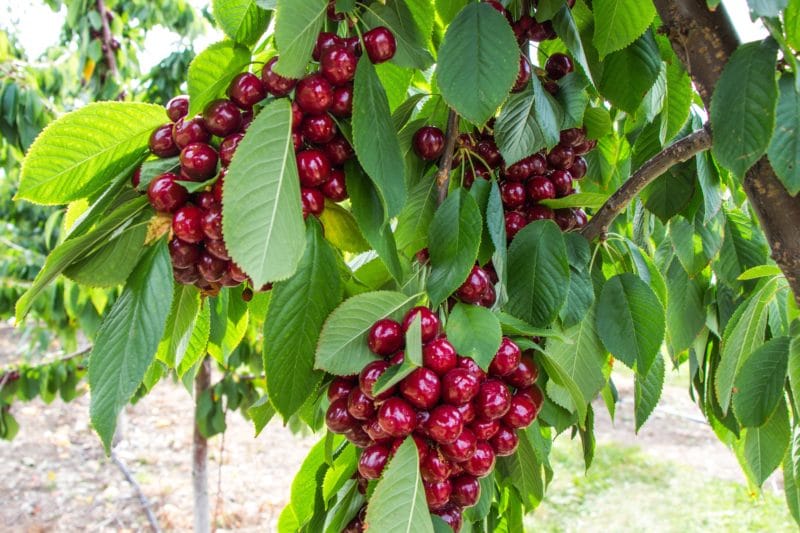
How to spray cherries
They fight the cherry fly depending on the season and the degree of damage to the plants. The most effective are chemicals. They are cheap and easy to use, it is only important to follow safety precautions.
Effective chemicals:
- "Phasis";
- "Aktellik";
- "Spark";
- "Fufanon";
- "Aktara";
- "Lightning";
- "Agita".
Anti-worm chemicals in cherries act either on the pest’s digestive system or on the nervous system, thereby causing poisoning or paralyzing breathing, which leads to death.
Reference. Experienced gardeners recommend alternating spraying preparations, as the fly quickly adapts to the same substance.
Preparations for worms on cherries
Means for controlling pests of cherry trees:
- "Inta-vir";
- "Kemifos";
- "Novaction";
- "Keminova".
These products are very toxic. When using them, you should use protective equipment and observe processing and waiting times.
How to get rid of cherry flies using folk remedies
Although the cherry fly is hardy, it can also be fought with traditional methods. Gardeners usually use 2 main mixtures:
- Tobacco-soap. From 0.5 to 1 kg of tobacco dust is diluted in 10 liters of hot water, left for 24 hours, and then boiled for half an hour. Next, grind the laundry soap into powder and add to the solution: 40 g per 10 liters of water. The mixture is diluted with water 1:2 and sprayed on the cherries.
- Pine needle solution. A large pan or bucket is filled with spruce or pine needles, poured boiling water and boiled for 30 minutes. The strained solution is sprayed onto the plants.
The pest also does not like the smell of iodine. 40 drops of the substance are diluted in a bucket of water and used for spraying.
Attention! For early varieties It is prohibited to use chemicals for cherries. In these cases, gardeners promptly begin to fight the pest using traditional methods.
When to spray cherries against cherry flies

Cherries will have to be treated against harmful insects in 3 stages.
- The first treatment is carried out in early spring, after the snow has melted and before the buds on the trees swell.At this stage, the pest pupae are removed.
- The following treatment is necessary for cherries during flowering. At this time, the fly is already beginning to fly and cause harm.
- The trees are sprayed again at the beginning of fruiting.
Features of spraying after flowering
When the cherries fade and fruits begin to set, the treatment is carried out carefully and with more gentle preparations.
During this period, broad-spectrum biological products “Bikol” or “Gaupsin” are used. During fruiting, trees are sprayed no later than 20-25 days before harvesting.
Cherry fly traps
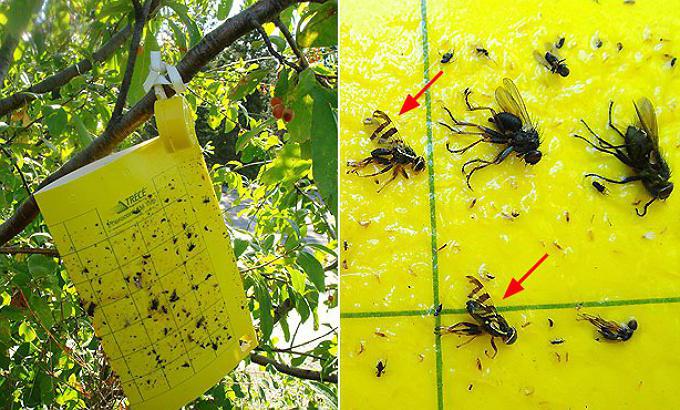
A trap is a kind of indicator for identifying a pest. You can buy it in a store or make it yourself. To do this, take a sheet of plywood or durable cardboard and paint it yellow.
For bait, mix 1 tbsp. l. rosin, 1 tbsp. l. honey or jam and 2 tbsp. l. castor oil, heat so that the ingredients dissolve, and apply to the prepared sheet of plywood. They hang him on a tree.
The fly is attracted by the sweet smell of honey, it sits on the plywood and sticks so that it can no longer fly out and lay eggs in the berries.
Every day you need to check how many flies are caught in the trap. If you count more than 20-25 of them, it’s time to spray the cherries.
Gardeners advise hanging several traps throughout the area.
Reference. Cherry fly worms prefer late and mid-late cherries varieties. The early ones often have time to ripen before the pest appears.
Worms in cherries: preventative measures
You can reduce the likelihood of flies by planting early varieties of cherries. But this does not guarantee that the pest will bypass your trees. It is better to follow basic preventive measures:
- The fly loves to feed on cherry aphids, so it is necessary to deprive the pest of its food supply. Trees are sprayed with infusion of tobacco or wormwood. Melissa, marigolds and marigolds also repel aphids.
- In early spring and late autumn, the tree trunk circle is dug up to a depth of 40 cm. The larvae from underground fall into the cold and die.
- When harvesting, not a single berry should remain on the tree. The remaining fruits may contain larvae.
- When spraying cherries, not only the trees are treated, but also the ground underneath them.
- All padans are carefully removed and burned outside the site.
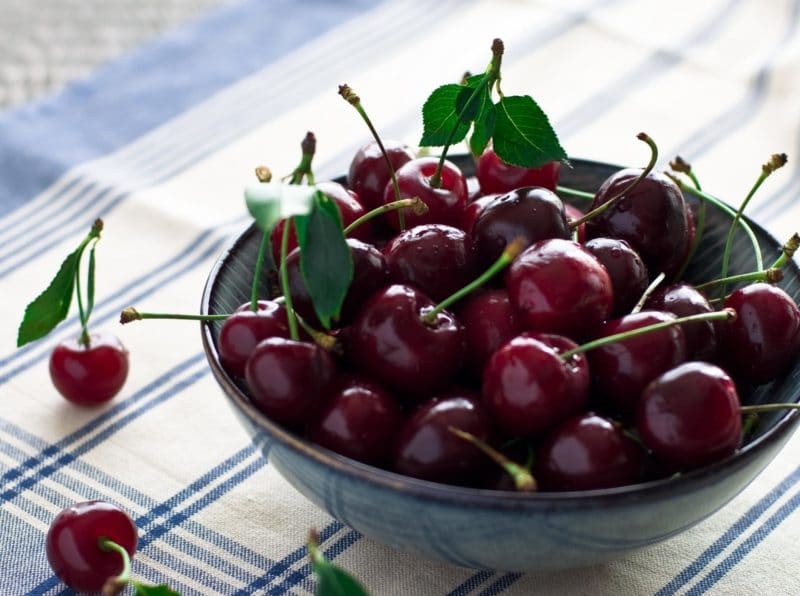
How to use wormy cherries
To save the berries, place them in salted water at room temperature - dissolve 3 tsp in 3 liters. salt. The berries are completely filled. After about 30 minutes, the worms crawl out and find themselves on the surface of the water.
The berries are washed under running water. After this they become suitable for consumption.
If the worms have already eaten away the pulp to a porridge-like mass, jam can be made from such berries. The fruits are first soaked in water so that the worms float to the surface. Properly prepared jam is not inferior in taste to that made from pure berries.
Conclusion
To grow a harvest of cherries and cherries in your garden, follow preventive measures, monitor the appearance of pests, process and feed the plants. Well, if the worms still managed to settle in the fruits, do not throw them away, but use them for jam, having first removed the insects.